2015 AIGA Medalist: Emory Douglas

Recognition
2015 AIGA Medal
Born
1943, Grand Rapids, Michigan
By Pitchaya Sudbanthad
September 1, 2015
Recognized for his fearless and powerful use of graphic design in the Black Panther party’s struggle for civil rights and against racism, oppression, and social injustice.
When creating great work, any artist or designer can expect to face obstacles. For Emory Douglas, the obstacles were set in place by the U.S. Federal Government. As the revolutionary artist and minister of culture for the Black Panthers from 1967 to the early 1980s, Douglas and his fellow party members endured acts of sabotage by the FBI. According to a congressional report, those acts included spraying production equipment with synthetic fecal scents, ransacking offices, and destroying shipments of newspapers that featured Douglas’ controversial graphics.
What did the government have to fear from Douglas’ work? His ability to provoke. The visual messages Douglas helped to propagate through the Black Panther Party’s media outlets unnerved many who had already been made anxious by the climate of unrest and revolution, and the perceived danger of his images is a testament to their potency.
“Artists have a way of instantly communicating essence,” says Douglas. “Things are made clear, almost like a language, and so art is a powerful tool to communicate with the community.”
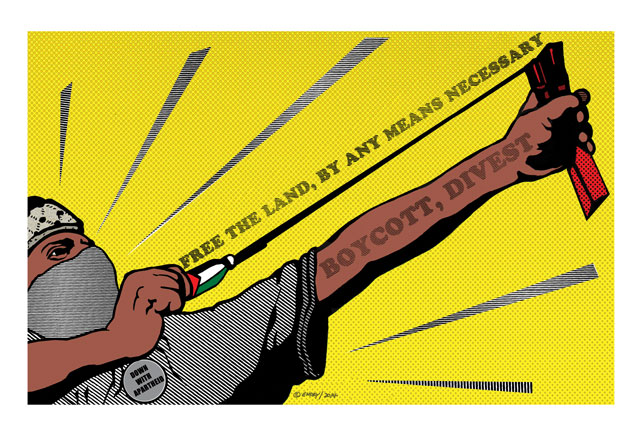
"Free the land," 2014.
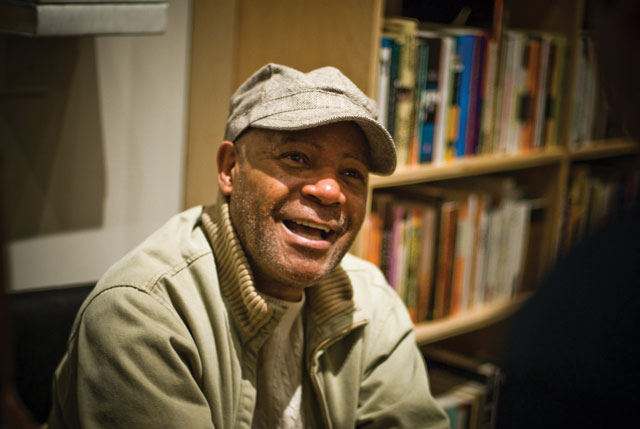
Emory Douglas portrait by Shaun Roberts.
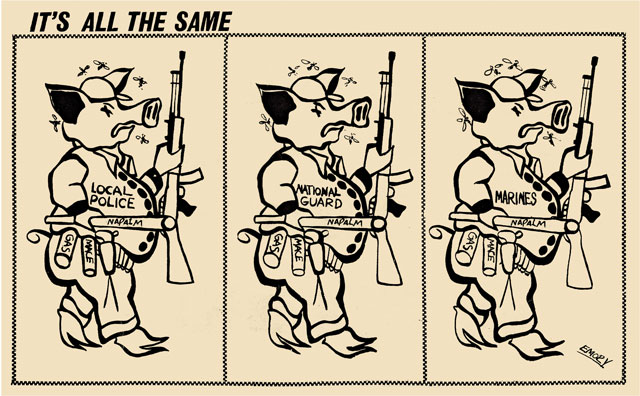
Photograph of Fred Ota, Tom Miller, John Weber, 1953. Thomas H. E. Miller Design Papers, Special Collections and Archives, University of Illinois at Chicago.
Raised in a single-parent household by his legally blind mother, Douglas had an uneventful childhood, but his life veered in a different direction after moving to the Bay Area in 1951. After a series of run-ins with the law, he was incarcerated for 15 months at the Youth Training School in Ontario, California, where he worked in a print shop that made product labels for businesses. “It was my first experience with graphic production,” says Douglas. “The guy who supervised it showed me how to design those labels myself.”
Though he couldn’t use the juvenile facility’s machines for his own creative purposes, he did learn the basics of typography and layout. Years later, he enrolled at City College of San Francisco, where he gravitated towards the commercial art classes that taught him the skills he needed for large-scale print production. He began making flyers, programs, and pamphlets for student groups working to advance civil rights and self-determination for African-Americans.
“I was using very basic materials, like rub-off type and markers, and applying what I had learned. It felt good to be contributing,” says Douglas. By the time he met Huey P. Newton and Bobby Seale—founders of the newly formed Black Panther Party—during a 1967 meeting at Eldridge Cleaver’s apartment. Douglas was keen to join, and the party wanted his vision and skills for its official newspaper.
The Black Panther was not the most sophisticated publication. Douglas had a limited set of tools at his disposal—two-color offset printing, with every graphic asset manually composed by rudimentary and often time-consuming means. Still, he was able to give the party’s social and political agenda a coherent visual identity and continuity. At its peak, the paper drew the attention of hundreds of thousands of readers.
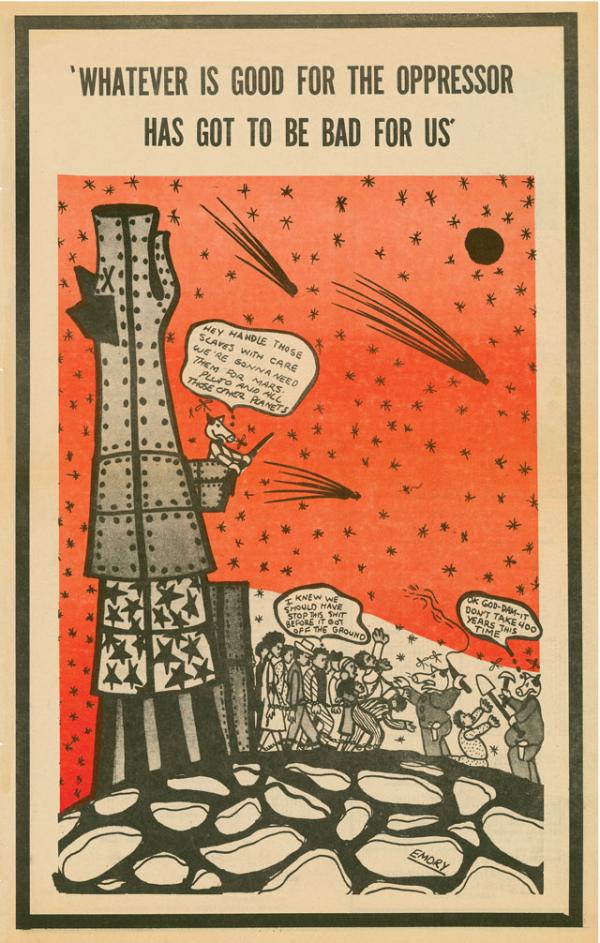
"Pig machine," 1969.
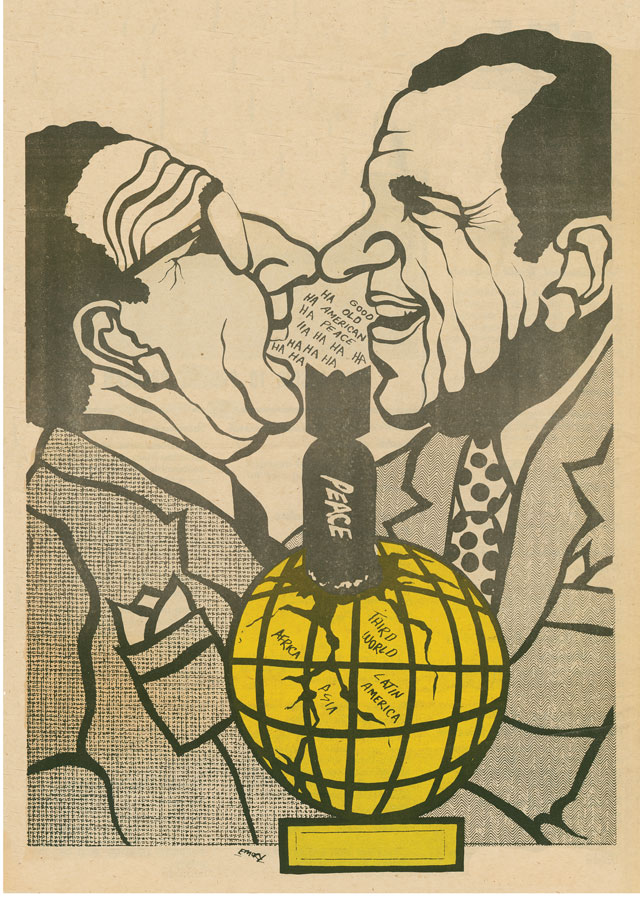
"Good old American peace," 1973.
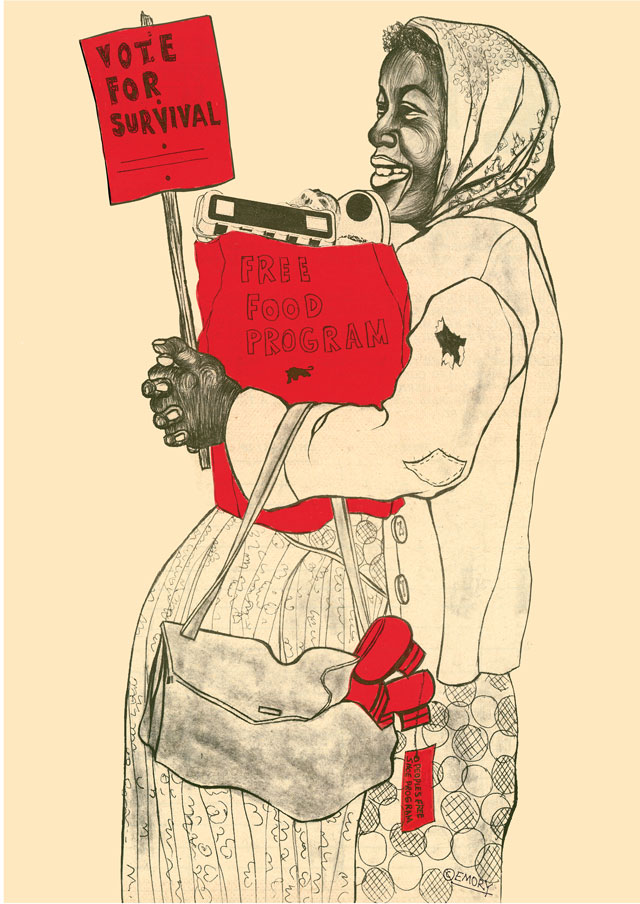
"Vote for survival," 1972.
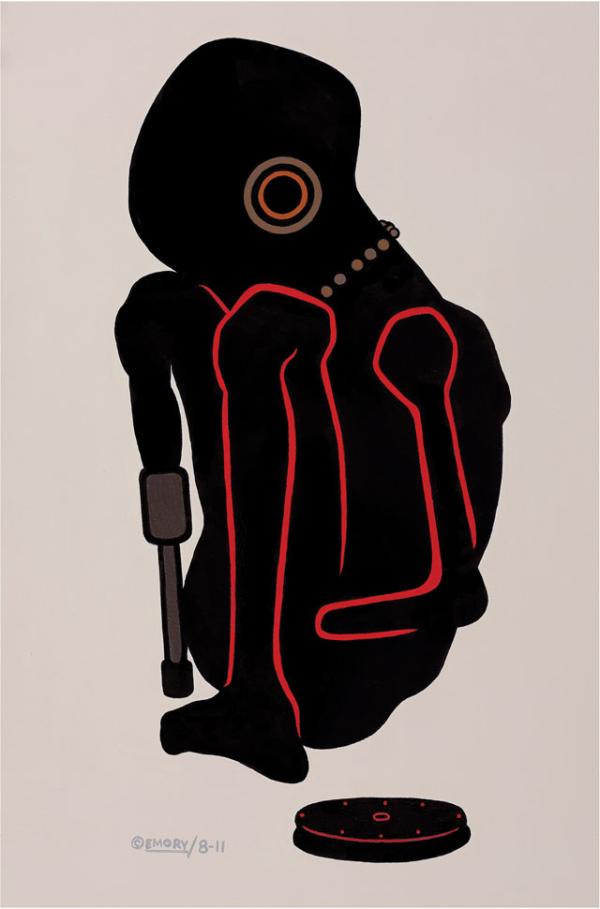
"Landmine," 2011.
It’s important to understand the nature and context of Douglas’ work during that period in U.S. history—decades before it was exhibited on the pristine walls of cultural institutions such as the New Museum and the Museum of Contemporary Art in Los Angeles. When The Black Panther was still in publication, young idealists were tearing out sheets and wheat-pasting them all over black neighborhoods. As street propaganda posters, Douglas’ full-page images, paired with bold headlines or quotes communicated the party’s message in the manner of advertisements put out by the very corporations he opposed. But instead of suggestive appeals to buy toothpaste or a new car, Douglas promoted calls to action in the communities where the paper was distributed:
Seize the time!
In revolution, one wins or one dies.
All power to the people.
And even if someone wasn’t able to read the paper’s message, they could grasp its intent and sense the energy in the bold lines of Douglas’ illustrations. No doubt they were also struck by a visual vocabulary of protest they had never seen before.
If those in power saw Douglas as a dangerous usurper of the established order, Douglas’ work showed that he was not only ready to accept that role, he seems to have been delighted in upending entrenched social and cultural archetypes. In place of depictions of African-Americans as subservient or as vilified criminal menaces, Douglas’ posters and newspaper illustrations depicted courageous people unafraid to speak for themselves and strive—oftentimes armed—for just treatment. Oppressive politicians and institutions were hung in effigy or viciously berated in parody. With police brutality endemic in black neighborhoods, Douglas retaliated by depicting policemen as abusive “pigs”—a term he helped to popularize in the parlance of the counterculture.
This shift emboldened the black community. Their collective anger had finally found tangible, incisive expression. “They started seeing themselves as heroes,” says Douglas. “Some even said they recognized family members in those images. The community could identify with the struggle because what they saw wasn't watered down. It didn’t negate the suffering or the love. It was relevant to them.”
Douglas’ guerrilla graphics made it possible for many to consider defiance as an alternative to victimization. Through his images, localized activism became connected to the worldwide revolutionary tide that had risen. If everyone fought back, change was possible anywhere.
For Douglas, his work for the Black Panther Party was only the beginning of a lifelong devotion to making art for causes he supports. He kept up his attacks on racism, greed, and the prison system long after the party dissolved in the early ’80s due to government persecution as well as its own internal conflicts. With renewed interest in the tumult that defined the latter half of the 20th century, a younger generation of political artists has now discovered Douglas’ work, further evidence that the pulse it carried more than three decades ago still beats strongly today.
“The fact that there’s so much surveillance happening shows that governments are still not responding to the needs of the people,” says Douglas. And so the struggle continues. In 2011, Douglas drafted Views and Intentions: A Political Artist Manifesto. Within it, he prescribes 12 objectives for politically motivated artists to keep in mind as they work to instigate change in a world made even more complex by digital design, the internet, and new forms of authoritarian responses. His final piece of advice: Do not lose sight of what the goals are.
Resources
Durant, Sam, ed. Black Panther: The Revolutionary Art of Emory Douglas. New York: Rizzoli, 2007. Print.
Sudbanthad, Pitchaya. “Emory Douglas.” AIGA, 2008. Web.
“Views and Intentions: A Political Artist Manifesto.” Premsela. The Netherlands Institute for Design and Fashion, 2011. Web.
Rayner, Alex. “Fight the Power.” The Guardian 24 Oct 2008. Web.